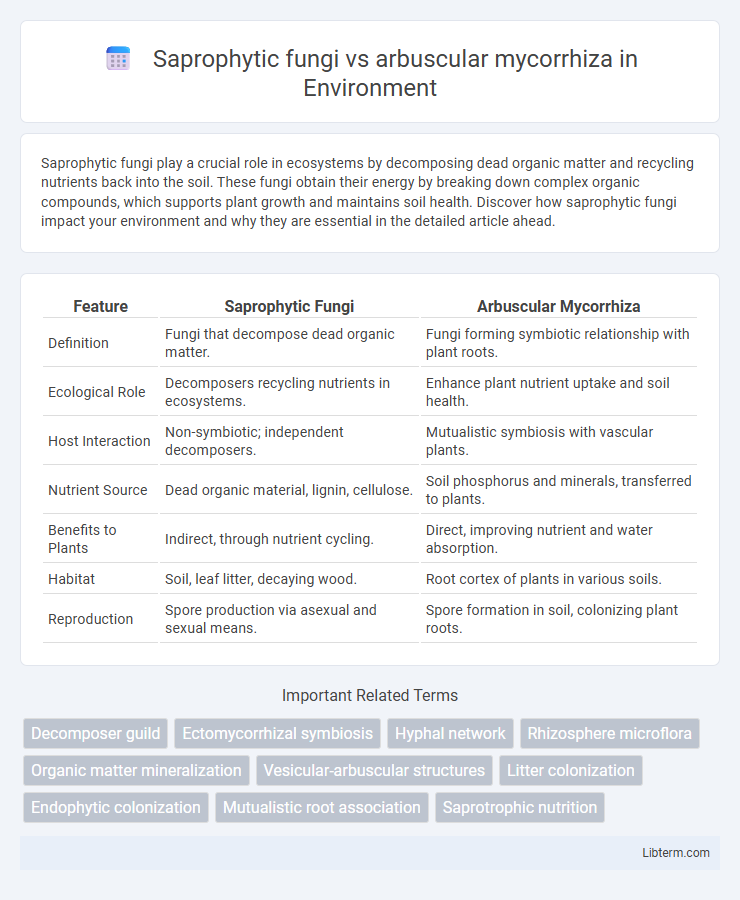Saprophytic fungi play a crucial role in ecosystems by decomposing dead organic matter and recycling nutrients back into the soil. These fungi obtain their energy by breaking down complex organic compounds, which supports plant growth and maintains soil health. Discover how saprophytic fungi impact your environment and why they are essential in the detailed article ahead.
Table of Comparison
| Feature | Saprophytic Fungi | Arbuscular Mycorrhiza |
|---|---|---|
| Definition | Fungi that decompose dead organic matter. | Fungi forming symbiotic relationship with plant roots. |
| Ecological Role | Decomposers recycling nutrients in ecosystems. | Enhance plant nutrient uptake and soil health. |
| Host Interaction | Non-symbiotic; independent decomposers. | Mutualistic symbiosis with vascular plants. |
| Nutrient Source | Dead organic material, lignin, cellulose. | Soil phosphorus and minerals, transferred to plants. |
| Benefits to Plants | Indirect, through nutrient cycling. | Direct, improving nutrient and water absorption. |
| Habitat | Soil, leaf litter, decaying wood. | Root cortex of plants in various soils. |
| Reproduction | Spore production via asexual and sexual means. | Spore formation in soil, colonizing plant roots. |
Introduction to Saprophytic Fungi and Arbuscular Mycorrhiza
Saprophytic fungi are organisms that decompose dead organic matter, playing a crucial role in nutrient cycling by breaking down complex organic compounds into simpler substances. Arbuscular mycorrhizae, on the other hand, form mutualistic associations with plant roots, enhancing nutrient uptake, particularly phosphorus, while receiving carbohydrates from the host plant. Both saprophytic fungi and arbuscular mycorrhizal fungi contribute significantly to soil health and plant growth through their distinct ecological functions.
Defining Saprophytic Fungi: Key Characteristics
Saprophytic fungi are organisms that obtain nutrients by decomposing dead organic matter, playing a crucial role in nutrient cycling and ecosystem sustainability. They secrete extracellular enzymes to break down complex organic compounds into simpler substances, which are then absorbed for growth and reproduction. Unlike arbuscular mycorrhiza fungi, which form mutualistic symbiotic relationships with plant roots to facilitate nutrient exchange, saprophytic fungi function independently without direct plant interaction.
Overview of Arbuscular Mycorrhiza: Essential Features
Arbuscular mycorrhiza (AM) fungi form symbiotic relationships with the roots of over 80% of terrestrial plant species, facilitating nutrient exchange by penetrating root cortical cells and developing characteristic arbuscules. Unlike saprophytic fungi that decompose organic matter externally for nutrients, AM fungi enhance phosphorus uptake and improve plant stress resistance through mutualistic interactions. These fungi belong to the Glomeromycota phylum and are critical for sustainable agriculture and ecosystem nutrient cycling.
Habitat and Ecological Niches
Saprophytic fungi thrive in decaying organic matter, decomposing dead plant and animal material primarily in forest floors, composts, and soil rich in organic residues, playing a critical role in nutrient cycling and organic matter breakdown. Arbuscular mycorrhizal fungi form mutualistic associations with the roots of most terrestrial plants, inhabiting the rhizosphere and enhancing nutrient uptake, particularly phosphorus, in diverse ecosystems such as grasslands, tropical forests, and agricultural soils. These distinct ecological niches highlight saprophytes' role in decomposition versus arbuscular mycorrhizae's function in plant nutrient acquisition and soil health.
Nutritional Strategies: Decomposition vs Symbiosis
Saprophytic fungi obtain nutrients by decomposing dead organic matter, releasing enzymes that break down complex compounds like cellulose and lignin into simpler molecules for absorption. Arbuscular mycorrhizal fungi form mutualistic symbiotic relationships with plant roots, facilitating nutrient exchange by transferring essential minerals such as phosphorus from the soil to the host plant in exchange for carbohydrates. The saprophytic strategy emphasizes independent nutrient acquisition through decomposition, while arbuscular mycorrhizae rely on symbiosis for efficient nutrient cycling and enhanced plant growth.
Role in Soil Health and Nutrient Cycling
Saprophytic fungi play a critical role in soil health by decomposing organic matter, breaking down complex carbon compounds, and releasing nutrients such as nitrogen and phosphorus back into the soil. Arbuscular mycorrhiza fungi form symbiotic associations with plant roots, enhancing nutrient uptake, particularly phosphorus, and improving soil structure through hyphal networks. Both contribute significantly to nutrient cycling, with saprophytic fungi accelerating organic matter decomposition and arbuscular mycorrhiza optimizing plant nutrient absorption and soil aggregation.
Influence on Plant Growth and Development
Saprophytic fungi enhance plant growth by decomposing organic matter, releasing essential nutrients like nitrogen and phosphorus into the soil, which improves soil fertility and nutrient availability. Arbuscular mycorrhizal fungi form symbiotic associations with plant roots, increasing water and mineral uptake while stimulating root system development and enhancing plant resilience to environmental stresses. Both fungi types significantly contribute to plant development but through distinct mechanisms: nutrient recycling by saprophytes and direct nutrient exchange and signaling by mycorrhizas.
Adaptations to Environmental Conditions
Saprophytic fungi possess enzymes that efficiently decompose organic matter, enabling survival in nutrient-poor and decaying environments. Arbuscular mycorrhiza form symbiotic relationships with plant roots, enhancing nutrient uptake, particularly phosphorus, under diverse soil conditions. Their hyphal networks extend beyond the root zone, increasing access to water and minerals in stressful environments like drought or poor soils.
Importance in Agriculture and Ecosystem Sustainability
Saprophytic fungi play a crucial role in agriculture by decomposing organic matter, recycling nutrients, and improving soil fertility, which enhances crop productivity and soil health. Arbuscular mycorrhizal fungi form symbiotic relationships with plant roots, increasing nutrient uptake, especially phosphorus, and boosting plant resilience to environmental stressors, thus promoting sustainable agriculture. Both fungi contribute significantly to ecosystem sustainability by maintaining soil structure, supporting plant biodiversity, and facilitating nutrient cycling essential for long-term agricultural productivity.
Comparative Analysis: Key Differences and Similarities
Saprophytic fungi obtain nutrients by decomposing dead organic matter, playing a crucial role in nutrient cycling and soil health, while arbuscular mycorrhiza form mutualistic associations with plant roots, enhancing nutrient uptake, particularly phosphorus. Both fungi contribute to ecosystem sustainability but differ fundamentally in their ecological roles: saprophytes act as decomposers, whereas arbuscular mycorrhizal fungi function as symbiotic partners. Despite these differences, both improve soil fertility and plant growth through nutrient exchange and organic matter processing.
Saprophytic fungi Infographic

 libterm.com
libterm.com